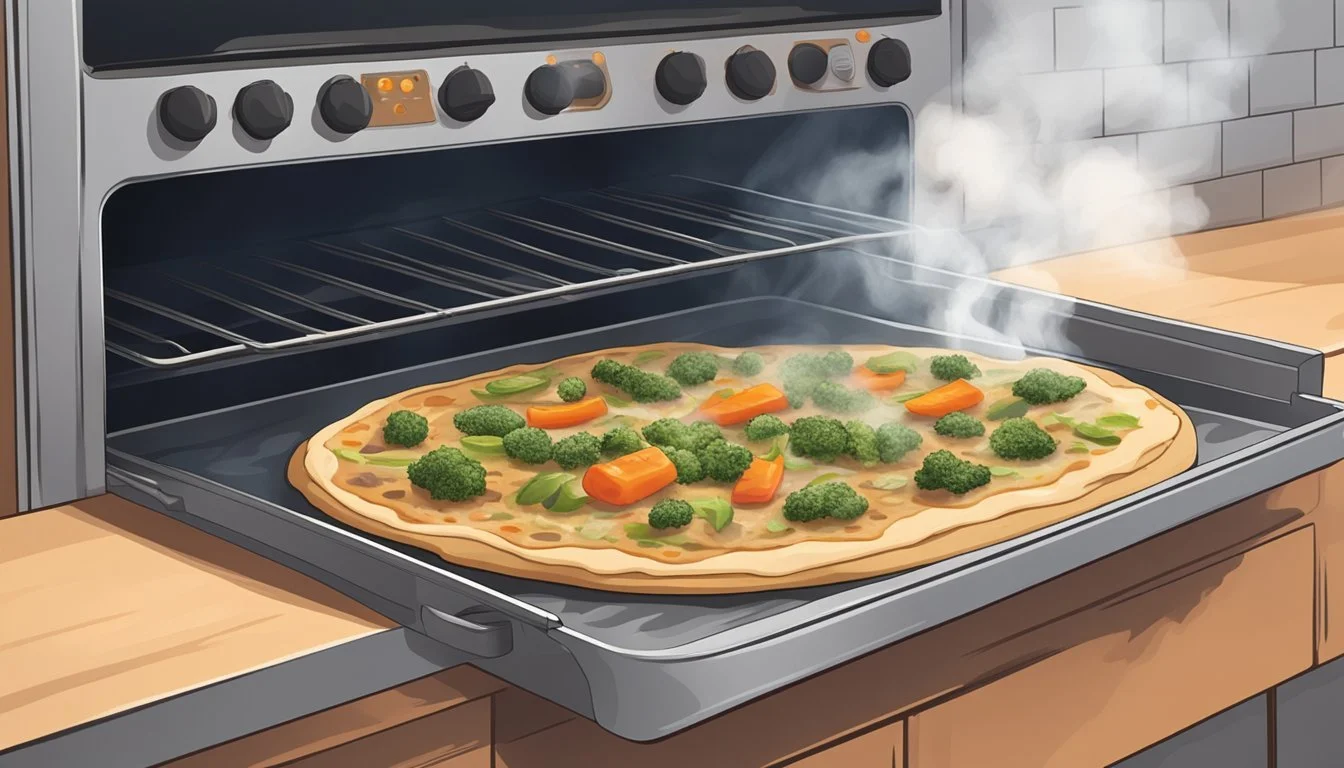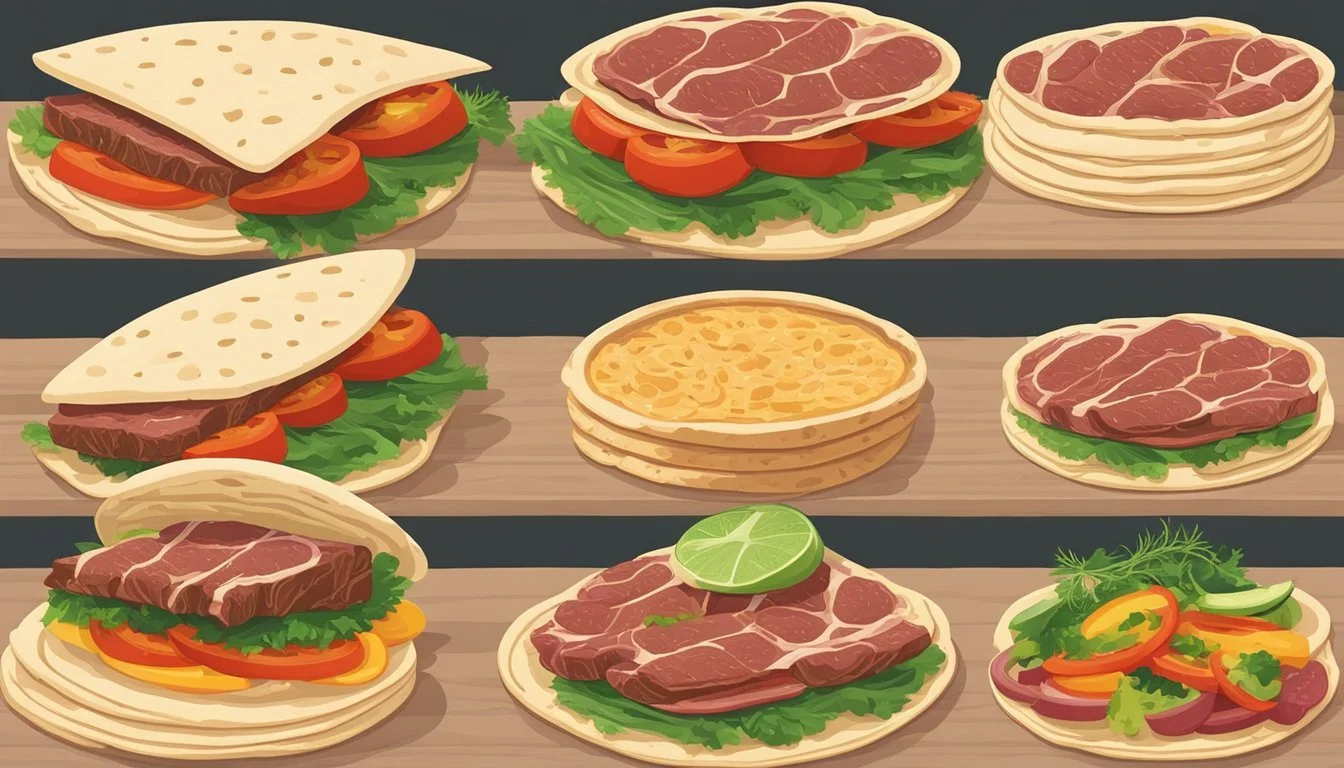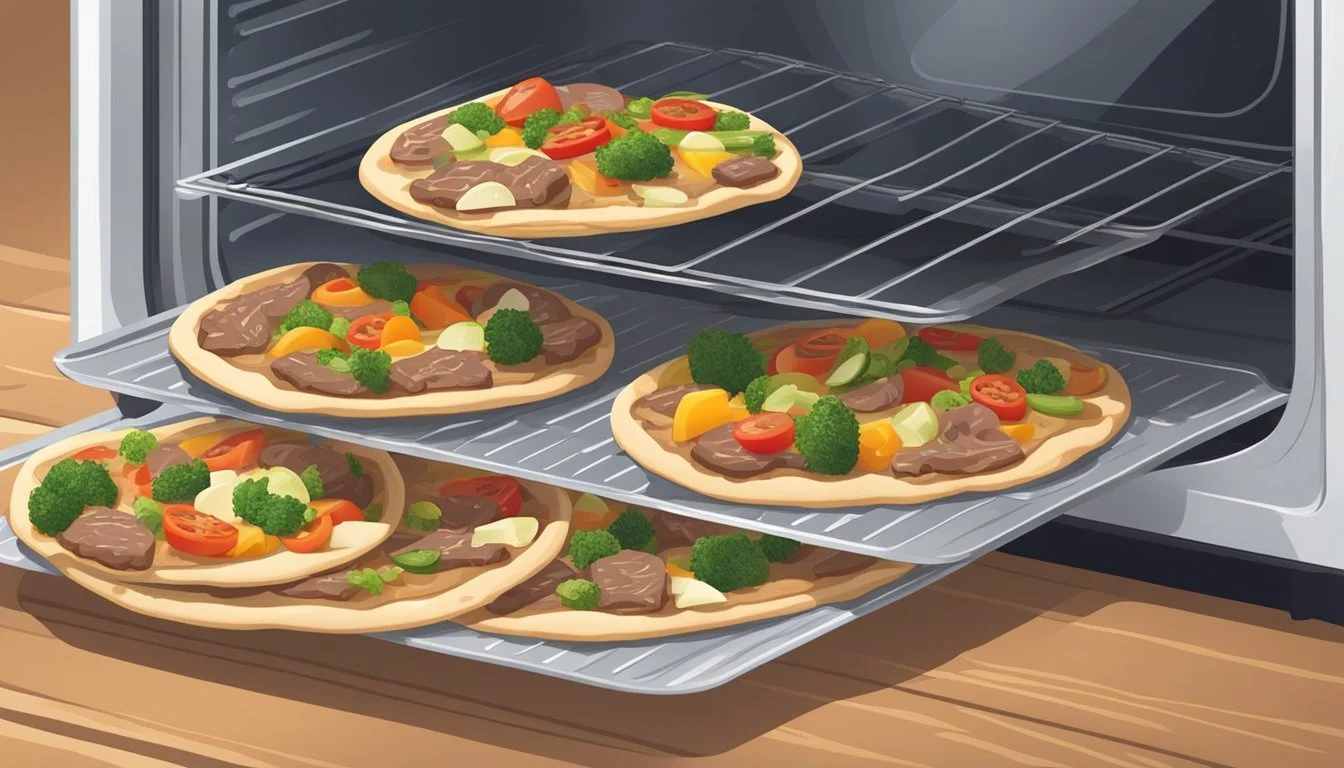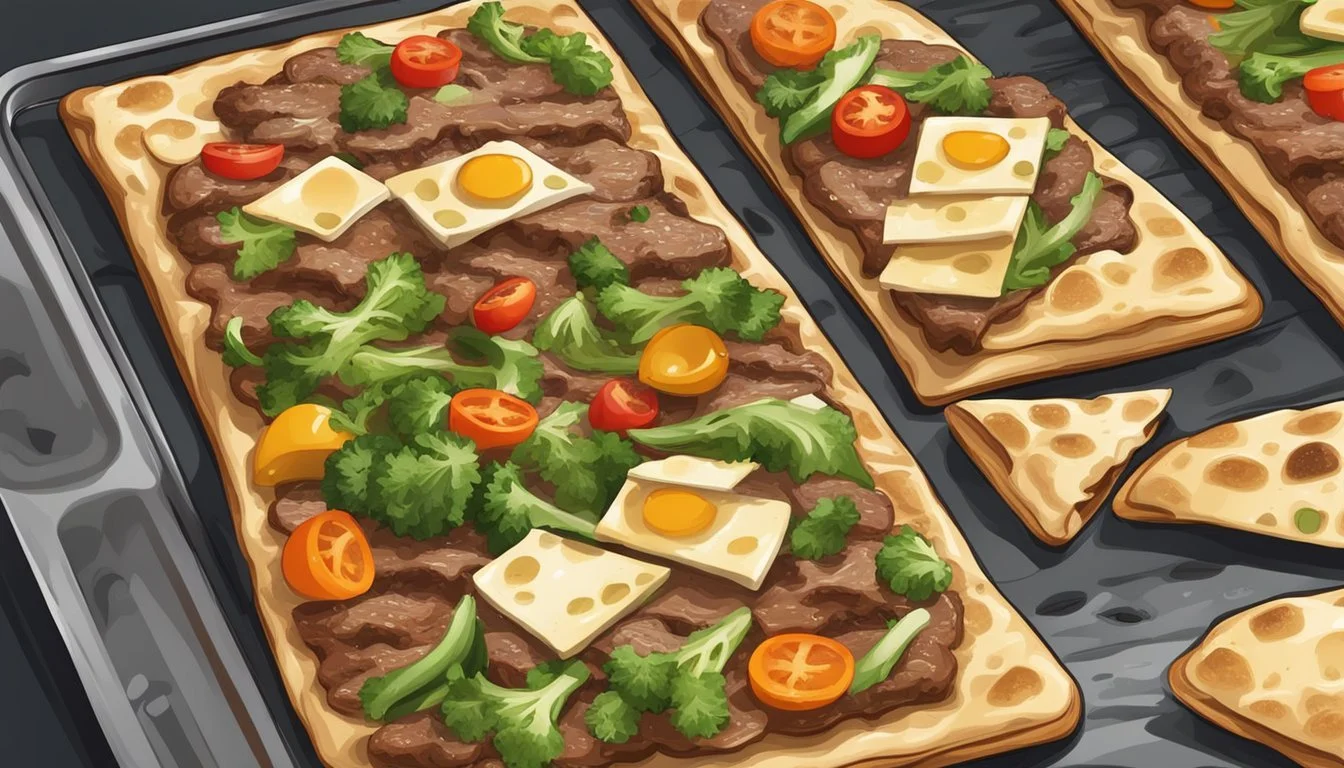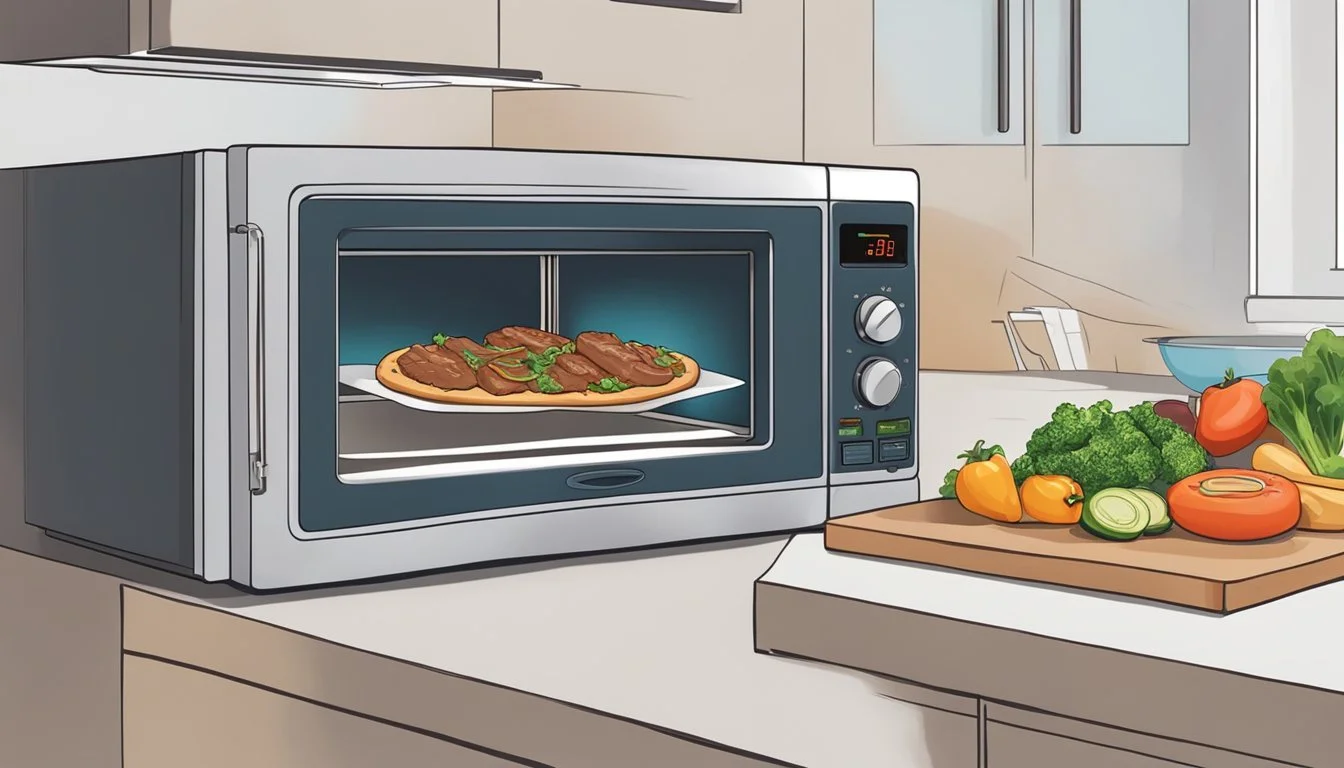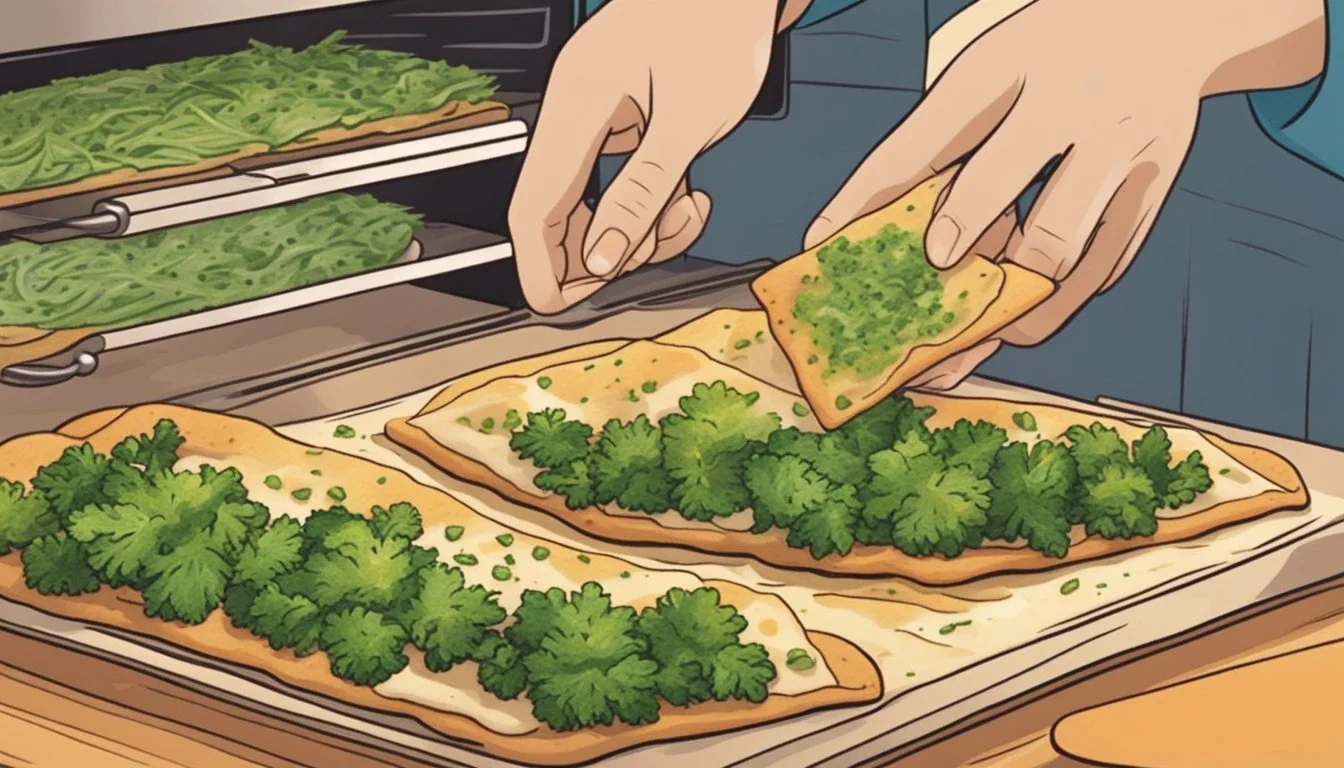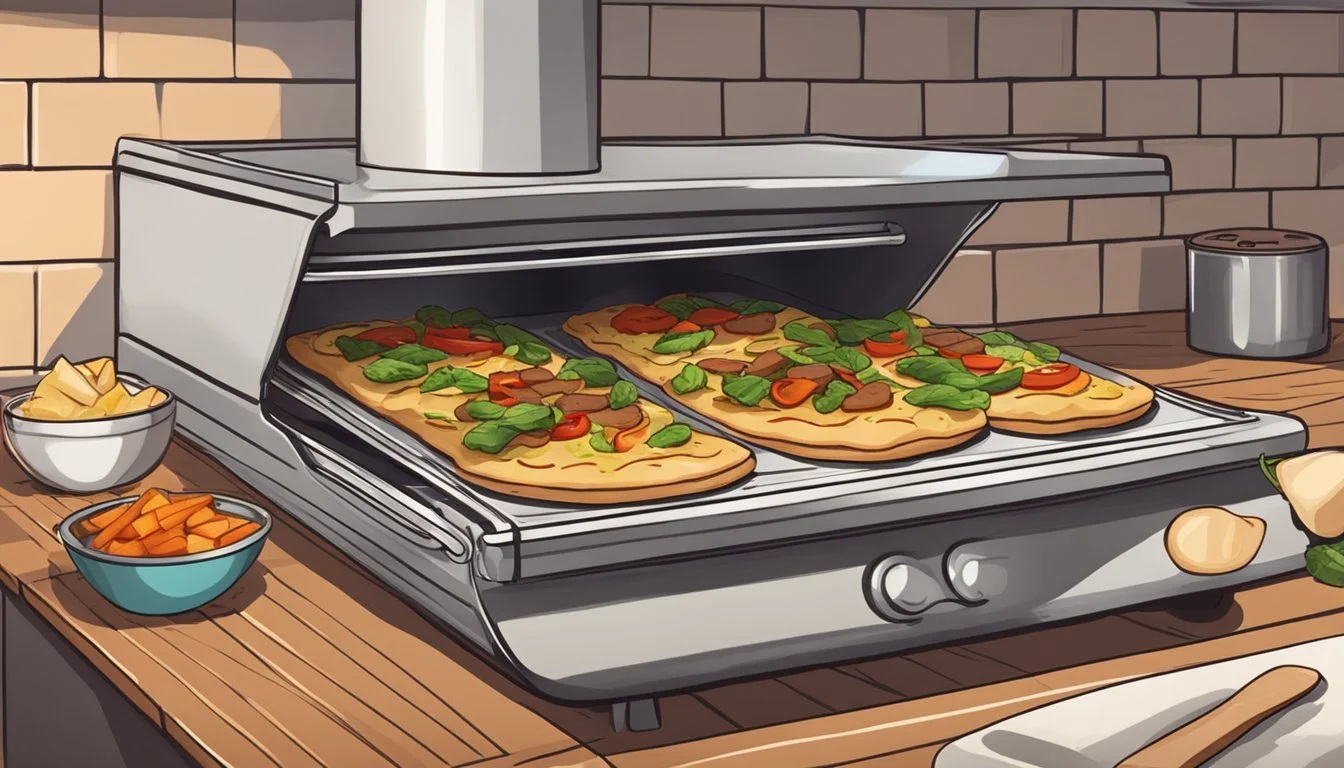How to Reheat Beef and Vegetable Flatbread
Best Methods Explained
Reheating beef and vegetable flatbread can be a daunting task if you're worried about losing the bread's texture or the filling's flavor. To keep your leftover flatbread just as delicious as when it was first made, start by preheating your oven to 350°F (180°C). Wrapping the flatbread in foil and sprinkling it with a bit of water helps maintain moisture, while a brief stint uncovered ensures a crispy finish.
Another effective method involves using a covered skillet to rejuvenate your flatbread. Preheat the skillet over medium heat, then place the flatbread inside and cover it. This approach allows the filling to heat evenly while keeping the crust appropriately crisp.
For a quicker solution, the microwave can also do the trick. Wrap individual pieces of flatbread in dampened paper towels and place them in a microwave-safe dish. Microwave on high power for approximately 15-20 seconds per piece or until heated through. This method requires careful monitoring to avoid overheating but can be a convenient option when time is short.
Understanding Flatbread Reheating Basics
Reheating flatbread correctly ensures it retains its flavor, texture, and nutritional benefits. The methods used can impact the moisture content, calories, protein, fat, and carbohydrates of the flatbread.
Types of Flatbreads
Flatbreads come in various forms, each with unique characteristics. Popular types include naan, pita, and tortillas. Naan is often thicker and softer, while pita has a pocket. Tortillas are thin and flexible. The reheating method may vary depending on the type, affecting the bread's flavor and nutrition. Thick flatbreads like naan benefit from oven heating to avoid excess moisture loss. Pita and tortillas can be efficiently reheated in a skillet or microwave, preserving their texture and nutritional content.
Benefits of Proper Reheating
Reheating flatbread correctly preserves its flavor and nutritional value. A well-reheated flatbread maintains the right balance of moisture, ensuring it doesn't become too dry or soggy. This also helps in retaining its calories, protein, fat, and carbohydrates. Proper reheating enhances the flatbread's overall quality, making it enjoyable to eat. Methods like oven heating, skillets, and microwaves, when used appropriately, ensure the flatbread's texture remains intact, and its nutritional benefits are maximized.
Preparing Beef and Vegetable Flatbread for Reheating
Proper preparation of beef and vegetable flatbread before reheating can make a significant difference in its final taste and texture. Key factors include storage methods and effective thawing processes.
Storage Solutions
Storage in Fridge: When planning to reheat within a couple of days, store leftover flatbread in the fridge. Wrap the flatbread tightly using plastic wrap or place it in an airtight container. This helps retain moisture and prevents flavors from mingling with other foods.
Storage in Freezer: For longer-term storage, freezing the flatbread is ideal. Wrap each piece of flatbread snugly with plastic wrap. Then, place the wrapped pieces in a freezer bag to minimize freezer burn. Make sure to label the bag with the date to keep track of storage time.
Thawing Techniques
Thawing in Fridge: Plan ahead and move the flatbread from the freezer to the fridge to thaw overnight. This gradual thawing maintains texture without introducing excess moisture.
Quick Thawing: If short on time, use the microwave to thaw. Place the flatbread on a microwave-safe dish and cover it with a damp paper towel. Set the microwave to defrost mode for a few minutes, regularly checking to avoid over-thawing which can lead to sogginess.
Reheating Methods Overview
There are several ways to reheat beef and vegetable flatbread effectively, each with its advantages. Some methods preserve the crispness of the flatbread, while others are quick and convenient.
Oven Method
Preheat the oven to 350°F (180°C).
Place the flatbread on a baking sheet and sprinkle a bit of water on the edges. Cover the flatbread loosely with aluminum foil to prevent it from drying out.
Heat for 5-10 minutes, checking at the halfway mark. Remove foil for the last 1-2 minutes to crisp the crust.
Skillet Method
Preheat a skillet over medium-high heat.
Lightly spray the flatbread with cooking oil or spread a thin layer of butter.
Place the flatbread in the skillet and cover it with a lid. Heat for about 15-20 seconds per side, ensuring it warms through without becoming too greasy.
Microwave Method
Place the flatbread on a microwave-safe plate.
Cover it with a microwave-safe lid or a damp paper towel to keep it moist.
Heat on medium power for 30-60 seconds, checking frequently to avoid overcooking. This method is quick but may not retain the flatbread’s crispness.
Air Fryer Method
Place the flatbread in a single layer in the air fryer basket.
Ensure there is no overlapping to allow even reheating.
Set the air fryer to 350°F (175°C) and heat for 2-3 minutes, checking for desired crispness. Adjust the time as necessary for optimal results.
Reheating in the Oven
To achieve the best results when reheating beef and vegetable flatbread in the oven, it's crucial to focus on proper preheating and the use of a baking sheet.
Preheating the Oven
Set your oven to 350°F (180°C). This temperature is ideal for warming the flatbread through while maintaining an excellent texture. Preheating ensures that the oven reaches the desired temperature before placing in the food, which can prevent uneven heating.
If you’re working with frozen flatbread, ensure it’s fully thawed, either by leaving it in the refrigerator overnight or using the microwave on a defrost setting.
Using a Baking Sheet
Place the flatbread on a baking sheet lined with aluminum foil for easy cleanup. Brush the flatbread lightly with olive oil to add moisture and flavor. If the flatbread seems dry, sprinkling a small amount of water can help.
Cover the flatbread with more foil to keep the heat evenly distributed. Bake for 10-15 minutes, checking halfway through to ensure it's heating evenly. If you want a crispier texture, remove the top foil for the last 2-3 minutes.
For a more even texture and to avoid a soggy base, use a wire rack on top of the baking sheet to allow air circulation underneath the flatbread.
Reheating on the Stovetop
Reheating a beef and vegetable flatbread on the stovetop can help achieve a crisp texture while avoiding sogginess. Focus on using a skillet and managing moisture to maintain quality.
Using a Skillet
A medium-hot skillet is ideal for reheating beef and vegetable flatbreads. Preheat the skillet over medium heat to ensure even heating. Lightly coat the skillet with a small amount of oil or butter. This helps to prevent sticking and promotes a golden, crisp finish.
Place the flatbread in the skillet and cover it with a lid to trap heat. Heat for 2-3 minutes on each side, checking frequently to avoid burning. Use a spatula to press down gently on the flatbread, ensuring even contact with the skillet for consistent reheating.
Avoiding Steam and Soggy Flatbreads
Ensuring that the flatbread remains crisp and flavorful requires attention to moisture control. Avoid adding water or simmering the flatbread, as steam can cause it to become soggy. It's best to reheat flatbreads uncovered when possible to allow excess moisture to escape.
If the flatbread starts to release moisture, it's helpful to turn up the heat slightly for a brief period. This can help evaporate excess liquid without overcooking the toppings. Monitoring the process closely is key to preventing moisture buildup and maintaining a crisp texture.
Using the Microwave
To reheat beef and vegetable flatbread using a microwave, it's essential to use short bursts of heat and maintain moisture without creating sogginess.
Short Bursts of Heat
Microwaves heat food quickly but unevenly. To ensure the beef and vegetables in the flatbread are heated thoroughly, use short bursts of heat. Start by placing the flatbread on a microwave-safe plate.
Set the microwave to medium power (about 50%). Heat the flatbread for 30 seconds at a time.
After each burst, check the temperature. Repeat until the flatbread is warmed evenly.
Using short bursts helps avoid overheating and ensures all components, including the beef and vegetables, are reheated properly.
Maintaining Moisture without Sogginess
One challenge when reheating flatbread in the microwave is maintaining moisture. To prevent the beef and vegetables from drying out, cover the flatbread with a damp paper towel.
This technique locks in moisture while avoiding sogginess.
If the flatbread has a high vegetable content, consider using a microwave-safe cover or plastic wrap labeled safe for microwaves to maintain the right moisture balance.
By controlling the moisture effectively, the reheated flatbread will be as enjoyable as when it was freshly made.
Employing the Air Fryer
Using an air fryer to reheat beef and vegetable flatbread is an efficient way to ensure it remains crispy and evenly heated. Key aspects include proper preheating and setting the right temperature and timing for effective reheating.
Preheating the Air Fryer
Preheating the air fryer is crucial for optimal results. Set the air fryer to 350°F (175°C). Allow it to run empty for about 3-5 minutes. This ensures the appliance reaches the desired temperature, promoting even heating.
Preheating preps the air fryer basket to quickly reheat flatbreads without becoming soggy. This step also helps maintain a crisp texture in both the beef and vegetable components of the flatbread.
Air Fryer Temperature and Timing
For reheating, maintain the air fryer at 350°F (175°C). Place the flatbread in a single layer in the air fryer basket, avoiding any overlap. This step is key to achieving uniform reheating and crispness.
Reheat the flatbread for 2-4 minutes. Check for warmth and crispness, using the time as a guideline and adjusting as needed. If the flatbread is not crisp enough, extend the time in 1-minute increments.
By doing so, the beef retains its flavor, and the vegetables remain tender, while the flatbread itself stays crisp. Remember, the goal is to evenly reheat without drying out the ingredients.
Finishing Touches for Enhanced Flavor
Enhancing the flavor of reheated beef and vegetable flatbread involves selecting the right fresh ingredients and condiments. These additions can significantly elevate the taste and texture of your dish.
Adding Fresh Ingredients
Incorporate fresh ingredients like lettuce, tomatoes, or onions to add a burst of freshness and crunch to the reheated flatbread. Thinly sliced bell peppers or cucumber can also provide a crisp texture.
For extra flavor, consider freshly chopped herbs like basil, oregano, or cilantro. These herbs introduce vibrant flavors that complement both the beef and vegetable components.
A sprinkle of grated cheese, such as mozzarella or parmesan, can enhance the taste without overwhelming the other ingredients. Lastly, for a touch of acidity and brightness, add a squeeze of lemon juice.
Choosing the Right Condiments
Selecting the right condiments is crucial for bringing out the best flavors in your flatbread. Opt for condiments like olive oil for its rich, fruity taste. Drizzle a bit of high-quality olive oil over your flatbread for a smooth finish.
If you prefer a bit of heat, add a dash of hot sauce or sriracha. These will add a spicy kick without overwhelming the dish.
For a touch of creaminess, consider spreads like hummus or tzatziki. These can balance the bold flavors of the beef.
Don't forget to season with salt and pepper to taste, ensuring every bite is perfectly flavorful. A final sprinkle of finely minced garlic can provide a pungent and aromatic touch to round out the dish.
Nutritional Information
Beef and vegetable flatbread offer a balanced mix of macronutrients and essential vitamins and minerals. The combination provides protein, vitamins A and C, iron, and fiber, making it a nutritious meal option.
Benefits of Beef and Vegetables
Beef is rich in protein, which is essential for muscle growth and repair. It also provides iron, helping to prevent anemia, and vitamin B12, which supports nerve function and red blood cell production.
Vegetables add significant nutritional value. They are high in fiber, aiding digestion, and are low in saturated fat and cholesterol. Key vitamins from vegetables include vitamin A, which supports vision and immunity, and vitamin C, which is crucial for skin health and antioxidant protection.
Including potassium-rich vegetables can help manage blood pressure, and calcium is vital for bone health. Sodium content should be monitored to avoid excessive intake, especially when using seasoned flatbread or marinades. Sugar levels are typically low in a beef and vegetable flatbread, making it a healthier choice.
Nutritional Content per Serving:
Protein: Approx. 20g
Iron: 15% of the daily recommended value
Fiber: 3-4g
Vitamin A: 40% of the daily recommended value
Vitamin C: 30% of the daily recommended value
This balanced nutritional profile makes beef and vegetable flatbread a fulfilling and health-conscious meal choice.
Serving and Presentation
Achieve an appetizing and visually appealing meal by following these serving suggestions and presentation tips, which ensure the flatbread looks as good as it tastes.
Serving Suggestions
For a complete meal, pair the beef and vegetable flatbread with a fresh, crisp salad or a side of roasted vegetables. These options add varying textures and complementary flavors to your dish. Alternatively, offer a selection of dipping sauces like garlic aioli or spicy sriracha to enhance the flavor.
For serving sizes, cut the flatbread into small, manageable pieces, making them perfect as appetizers or snacks. For a main meal, larger slices served with a side garnish work well. Always ensure that the flatbread is heated to the right temperature, warm but not too hot, to best enjoy its flavors and texture.
Presentation Tips
When it comes to plating, simplicity is key. Use a pizza stone or rustic wooden board for a casual, yet elegant presentation. Arrange slices slightly overlapping in a fan shape to create visual interest. For added color and freshness, sprinkle chopped herbs like basil or parsley over the flatbread right before serving.
Create a balanced look by adding colorful elements like cherry tomatoes or bell pepper strips alongside the flatbread. For a more festive table, place the flatbread on a white plate to contrast with the vibrant toppings. Use garnish sparingly to avoid overwhelming the main flavors of the beef and vegetables on the flatbread.
Alternative Recipes and Variations
When it comes to reheating beef and vegetable flatbread, creativity and health-conscious approaches can significantly enhance the dish. Exploring new recipes and utilizing leftovers can transform the flatbread experience.
Creative Twists with Leftovers
Using leftovers creatively can lead to unique and delicious variations of beef and vegetable flatbread. For instance, adding different types of cheese or sauces can introduce new flavors.
Mexican-Inspired Flatbread: Use taco-seasoned beef, black beans, and corn with a sprinkle of cheddar cheese. Top with avocado slices and a dollop of sour cream post-reheating.
BBQ Beef Flatbread: Spread a thin layer of barbecue sauce over the flatbread, add leftover beef, sliced red onions, and shredded mozzarella cheese. Garnish with fresh cilantro after reheating.
Italian-Style Flatbread: Incorporate sun-dried tomatoes, basil, and fresh mozzarella with the beef and vegetable mix. Finish with a drizzle of balsamic glaze.
Healthy Alternatives
For those focusing on healthful choices, there are several ways to modify the flatbread recipe. Whole grain or cauliflower flatbreads can replace traditional bases to increase fiber and lower carbs.
Whole Wheat Flatbread: Use a whole wheat flatbread base. Add grilled vegetables like zucchini and bell peppers with lean beef. Opt for a lower-fat cheese or nutritional yeast for a cheesy flavor.
Cauliflower Flatbread: Make a base out of riced cauliflower, eggs, and cheese. Top with a mix of roasted beef and vegetables. This option offers a gluten-free and low-carb alternative.
Vegan Variation: Replace beef with a plant-based meat alternative or marinated tofu. Use vegan cheese and load up on vegetables like spinach, mushrooms, and tomatoes.
Incorporating these alternatives can make reheated flatbread not only a meal but an opportunity to enjoy a nutritious and customized dish.
Safety and Preventive Measures
When reheating beef and vegetable flatbread, safety and preventive measures are crucial to avoid foodborne illness and kitchen accidents. Proper handling and reheating practices ensure that the food is both safe to eat and delicious.
Avoiding Foodborne Illness
Beef and vegetable flatbread must be reheated to the appropriate temperature to kill harmful bacteria. The internal temperature should reach at least 165°F (74°C). Use a food thermometer to verify this temperature, especially if reheating in an oven or microwave.
Store leftovers in airtight containers in the refrigerator and consume within 3-4 days. To prevent contamination, wash hands thoroughly before and after handling food and do not use the same utensils for raw and cooked ingredients. Avoid leaving the flatbread at room temperature for more than 2 hours to prevent bacterial growth.
Preventing Burns and Accidents
Carefully handle hot dishes and utensils to avoid burns. Use oven mitts when removing flatbread from ovens and microwaves. Place reheated flatbread on sturdy surfaces to avoid spills.
In microwaves, ensure even heating by stopping and stirring the flatbread halfway through. When reheating in ovens, check periodically for doneness to avoid overcooking and subsequent burns from overheating. Keep children and pets away from hot appliances to prevent accidental injuries. Maintain a clear workspace to minimize the risk of accidents.

